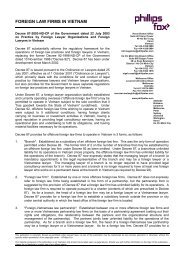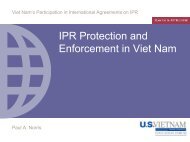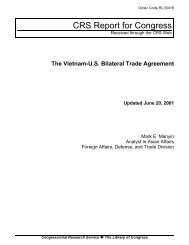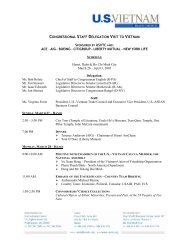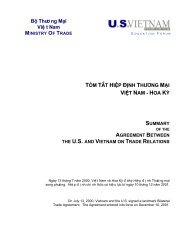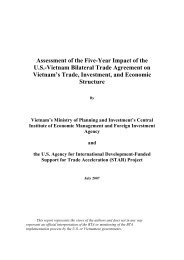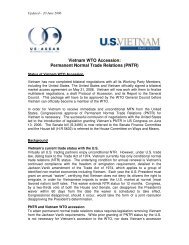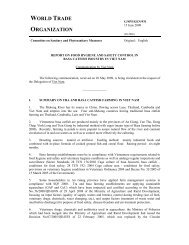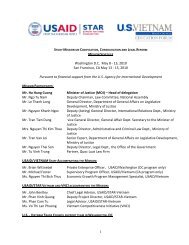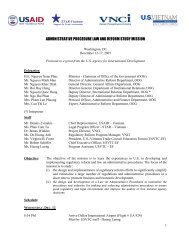Climate risks and adaptation in Asian coastal megacities: A synthesis
Climate risks and adaptation in Asian coastal megacities: A synthesis
Climate risks and adaptation in Asian coastal megacities: A synthesis
- No tags were found...
Create successful ePaper yourself
Turn your PDF publications into a flip-book with our unique Google optimized e-Paper software.
Damage costs constitute approximately 2–8percent of 2008 GDP for events of different<strong>in</strong>tensitiesS<strong>in</strong>ce Bangkok <strong>and</strong> Samut Prakarn are the twoareas that are ma<strong>in</strong>ly affected, flood damages arecompared to their gross regional domestic product(GRDP). Under assumptions of high emissions(2050-LS-SR-SS-A1FI), the impacts of a 1-<strong>in</strong>-30-yearflood <strong>in</strong> 2050 will amount to THB 148 billion (5percent of current GRDP). A bigger 1-<strong>in</strong>-100-yearflood would cost about 8 percent of current GRDP.49Similar sized floods would cost 1–3 percent ofGRDP under a no-climate-change scenario (2008),as <strong>in</strong>dicated <strong>in</strong> Table 4.4.To carefully estimate the costs of climate change,Table 4.4 compares 2050 flood damages with climatechange (2050-LS-SR-SS-A1FI) to a scenario wherethere is l<strong>and</strong> subsidence but no climate change(2050-LS). The net impact of climate change is thenthe difference <strong>in</strong> costs between these two scenarios.This amounts to THB 49 billion ($1.5 billion) <strong>in</strong> 2008values, or approximately 2 percent of 2008 GRDP.Prioritization ofAdaptation Options <strong>in</strong>BangkokAs discussed earlier, Bangkok has a long history offloods <strong>and</strong> its residents have developed numerous<strong>adaptation</strong> measures to cope with the risk of floods.A wealth of well-tested experience, <strong>in</strong>formation, <strong>and</strong>technology is already available to identify viable<strong>adaptation</strong> strategies. The Bangkok study reviewed<strong>and</strong> analyzed some of the more prom<strong>in</strong>ent practices<strong>and</strong> potential adaptive <strong>in</strong>terventions, such as improv<strong>in</strong>gflood forecast<strong>in</strong>g <strong>and</strong> prepar<strong>in</strong>g strategiesfor flood warn<strong>in</strong>gs, evacuation, transport dur<strong>in</strong>gfloods, <strong>and</strong> post-flood recovery; implement<strong>in</strong>gprotection (e.g. construction of dikes/seawalls) orretreat strategies for <strong>coastal</strong> development; changes<strong>in</strong> <strong>coastal</strong> development <strong>and</strong> l<strong>and</strong> use; <strong>and</strong> public<strong>in</strong>formation campaigns <strong>and</strong> tra<strong>in</strong><strong>in</strong>g exercises. Themunicipal agencies <strong>in</strong> BMR have also developedseveral plans for flood mitigation <strong>and</strong> dra<strong>in</strong>ageworks that <strong>in</strong>clude both structural <strong>and</strong> non-structuralmeasures. However, these plans do not <strong>in</strong>cludeclimate change considerations.The Bangkok study proposes a portfolio of <strong>adaptation</strong>options <strong>in</strong> the form of structural measuresthat can mitigate the impact of 1-<strong>in</strong>-30-year or 1-<strong>in</strong>-100-year floods.■■The results of the simulations <strong>in</strong>dicate that thecrest elevations of dikes around Bangkok <strong>and</strong>along both banks of the Chao Phraya River willnot be high enough to cope with flood<strong>in</strong>g ofmore than a 10-year return period <strong>in</strong> the future.Moreover, the protected area to the west of theChao Phraya River has <strong>in</strong>sufficient pump capacityto dra<strong>in</strong> the floodwater <strong>in</strong>to the Tha Ch<strong>in</strong>River <strong>and</strong> the Gulf of Thail<strong>and</strong>. Thus, the firstset of options <strong>in</strong>cludes dike <strong>and</strong> pump<strong>in</strong>g capacityimprovement.49In terms of GDP, the Bangkok study identifies the current2008 GDP for Bangkok <strong>and</strong> Samut Prakarn to be 2,916 billionTHB <strong>and</strong> estimates that GDP <strong>in</strong> 2050 will be 19,211 billionTHB. All damage costs are represented <strong>in</strong> 2008 THB, thus toestimate percent of GDP, 2008 GDP values were used.Table 4.4 ■ Damage Costs <strong>in</strong> Bangkok <strong>and</strong> Regional GRDPDamageCosts Million THB (2008) % of 2008 GRDPc2050-LS-SR-SS- Costs of <strong>Climate</strong>c2050-LS-SR-SS- Costs of <strong>Climate</strong>Mill THB C2008 C2050-LS A1FIChange C2008 C2050-LSA1FIChangeT 10 15,248 51,819 91,118 39,299 0.52 1.78 3.12 1.35T30 35,284 99,324 148,386 49,062 1.21 3.41 5.09 1.68T100 79,178 185,759 243,866 58,107 2.72 6.37 8.36 1.99Source: Based on estimates <strong>in</strong> Panya Consultants (2009).56 | <strong>Climate</strong> Risks <strong>and</strong> Adaptation <strong>in</strong> <strong>Asian</strong> Coastal Megacities: A Synthesis Report



